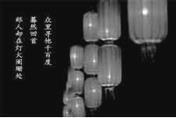短文理解 阅读下列短文,从每题所给的A、B、C三个选项中,选出最佳选项回答问题或完成句子。

The Lantern Festival falls on the 15th of the first month of the lunar calendar(阴历). This day is always the first full moon in the new year. Ancient people also called it Shangyuan Festival. Celebrations and traditions on this day began from the Han Dynasty(朝代)and became popular in the Tang Dynasty.
Watching the red lanterns is one of the main traditions. Lanterns of different shapes and sizes are usually put on trees, or along river banks on show. It is said that sky lantern's were first used by Zhuge Kongming to ask for help when he was in trouble. Today, when the lanterns slowly rise into the air, people make wishes.
Another tradition is guessing lantern riddles. The riddles are usually short, wise, and sometimes humorous. The answer to a riddle can be a Chinese character(汉字),a famous person's name, or a place name.
The most important thing is to eat sweet dumplings with different tastes. In northern China, they are called yuanxiao while in southern part they're named tangyuan. Because making sweet dumplings is like a game or an activity, they are usually done happily by a group of friends or family members.
In old times, the Lantern Festival was also romantic(浪漫的). Watching lanterns gave young people a chance to meet each other. A line from Xin Qiji, a poet during the Song Dynasty, shows this:
Hundreds and thousands of times I searched for her in the crowd. Suddenly I turned, and there she stood, in the dim(昏暗的)light.
A. 春节 B. 元宵节 C. 端午节